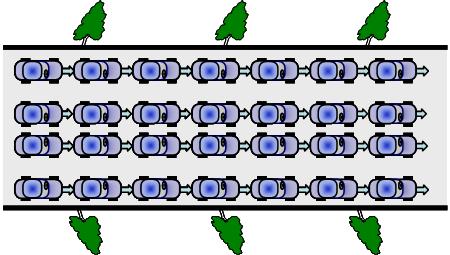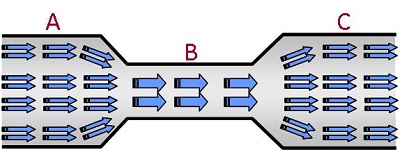A fluid is composed of molecules that we can imagine as so many beads. If the fluid is flowing in a pipe, these beads move like cars on a road.
If the diameter of the pipe does not vary, the flow speed remains constant. In the same way, on a very busy motorway, if the number of lanes remains constant the speed of the vehicles is stable.

To understand what happens in a pipe whose diameter changes we have to think of a motorway which is almost saturated. In a flowing pipeline the molecules follow each other, squeezed together, and no one overtakes.
What happens on a congested motorway if the number of lanes is reduced?
Note, to begin with, that on the diagram below, supposing that the vehicle flow is stabilized, the number of cars going past in one hour will be exactly the same whatever the number of lanes (in A,B, C).

If there are doubts about the number of cars going past per hour not being identical in A,B,C, we have to imagine three “policemen” placed at points A, B, and C in charge of counting the cars.
Obviously the policeman at point B will see the same number of cars pass by as the policeman at point A. It is the same thing for the policeman at point C. The quantity of cars going past A is in fact identical to the number going past points B and C.
In these conditions, if the number of cars going past in one hour at B in 2 lanes is identical to the number going through points A and C in 4 lanes, it is clear that traffic flow speed at B two time faster than at A and C.
Conclusion:
if the size of a pipeline or duct is reduced, the speed of the fluid will be faster than elsewhere.
On the other hand, if the size of a pipeline or duct is enlarged, the speed of the fluid will be slower

In a pipeline the speed of a moving fluid depends on the gauge size. The smaller the diameter of the tube, the faster the water flow, but greater the noise, and vice-versa.
